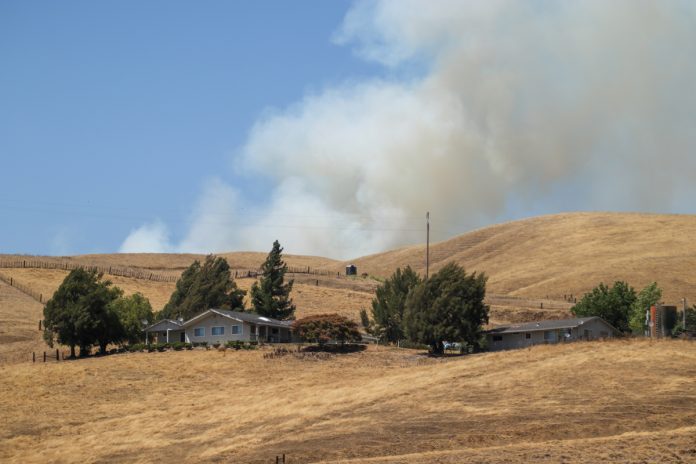Authorities continue to warn of harmful and deteriorating air quality as smoke drifts into the South Valley region from numerous wildfires burning in the Bay Area, Salinas Valley and beyond.
Residents likely woke up this morning with their vehicles covered in ashes and enough smoke filling the air to obstruct visibility and complicate breathing. The River Fire, burning south of Salinas, grew from about 4,000 acres Monday afternoon to more than 10,000 acres the morning of Aug. 19, according to CalFire authorities.
Firefighters are also fighting the SCU Lightning Complex Fire, which consists of numerous wildfires throughout the Bay Area that have collectively burned more than 85,000 acres as of Aug. 19. One of these fires is burning east of Morgan Hill and Gilroy in Henry W. Coe State Park, and another is ablaze in the Santa Cruz Mountains. Thousands of residents have been evacuated.
The fires have caused smoke pollution throughout the region, and residents are advised to stay indoors due to the poor air quality. The Bay Area Air Quality Management District rates the Aug. 19 air quality index in South Santa Clara County at 107, which falls in the category “Unhealthy for Sensitive Groups.”
The air quality forecast for Aug. 20 shows the AQI rating will worsen to 157 in South County, according to the BAAQMD website.
The Monterey Bay Air Resources District rated the air quality for San Benito County in the generally “Unhealthy” range.
“An unhealthy level is defined as some members of the general may experience health
effects: members of sensitive groups may experience more serious health effects,” says a press release from San Benito County. “If you see smoke in the air or smell smoke, then there can be risks to your health.”
San Benito County authorities included the following advice in the Aug. 19 press release:
What are the possible health effects?
Smoke from forest fires can cause:
– eye irritation, redness and eyestrain
– lung irritation, coughing and shortness of breath
– asthma attacks or worsening of existing asthma and respiratory allergies
Who is at highest risk?
– People with asthma, respiratory problems, heart problems and diabetes
– Infants and children
– Pregnant women
– Frail elderly
– People whose jobs require extended time outdoors
What can you do if you smell or see smoke in your area?
– The California Department of Public Health requires you to wear a mask when in
public.
– Those at high risk should stay indoors or consider temporarily leaving the area.
– Do not exercise outdoors. Limit exercise to the indoors such as in your home,
gymnasiums or fitness centers.
– Keep windows and doors closed. Use air conditioners if possible.
– Consider sending outdoor workers home.
– Do not create more smoke. Do not use woodstoves, fire pits or barbeques. Avoid using leaf blowers and weed whackers. Avoid driving your vehicles if you don’t need to.
– Keep indoor air as clean as possible. Do not use candles or incense, aerosol sprays, vacuum cleaners and other objects that can cause particles to rise into the air.
If you or someone you know is having trouble breathing, contact a health care provider for advice. Please be aware that air quality can change quickly as fires progress and wind changes direction. For real-time air quality reports go to mbard.org/airquality and www.cdc.gov/features/wildfires.















